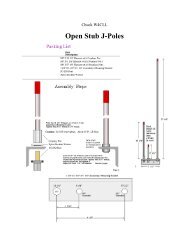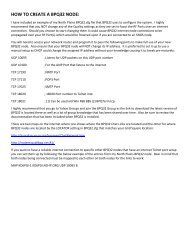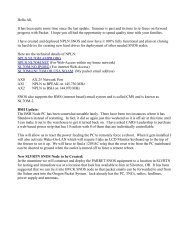NVIS - Cascade Amateur Radio Society
NVIS - Cascade Amateur Radio Society
NVIS - Cascade Amateur Radio Society
Create successful ePaper yourself
Turn your PDF publications into a flip-book with our unique Google optimized e-Paper software.
Regional Communications<br />
N.V.I.S.<br />
Near Vertical Incidence Skywave
▪ Local<br />
▪ Regional<br />
▪ Distant<br />
Communications<br />
Three major groups:
Local Communications<br />
Avoid distant interference<br />
Very Often Low-Power<br />
▪ Line of Sight (LOS)<br />
▪ Diffraction<br />
▪ Reflection<br />
▪ Repeaters
▪ VHF/UHF<br />
▸ 2 Meter<br />
▸ 440 (70 cm)<br />
▸ 220 ?<br />
▸ 6 meter ?<br />
Local Communication<br />
Frequencies
▪ HF: 3 – 30 M<br />
Long-Distance<br />
Typically Beyond 500 Miles
▪ Ground Wave<br />
▪ Direct Wave<br />
▪ Sky Wave<br />
HF Characteristics<br />
Pathways
HF Skywave<br />
Ionosphere Refraction<br />
Bent, NOT Reflected<br />
▪ Layers or Levels of ionization<br />
▸ D - Layer – 50-90 KM.-- Daylight only<br />
▸ E - Layer – 90-130 KM.<br />
▸ F - Layer – 300 KM.-- Night<br />
– F1 - Layer – 175-250 KM.-- Daylight only<br />
– F2 - Layer – 250-400 KM.-- Daylight only
HF Communication<br />
Directed to Specific Place<br />
▪ Propagation Characteristics<br />
▪ Pick Frequency<br />
▪ Alternates
▪ Direct<br />
▪ Ground Wave<br />
▪ Sky Wave<br />
Regional<br />
Distance Beyond Line of Sight (BLOS)<br />
But within “skip zone”
<strong>NVIS</strong><br />
Near Vertical Incidence Skywave:<br />
▪ Propagation mode involves:<br />
▸ antennas with very high radiation angle, approaching<br />
90 degrees<br />
▸ selection of appropriate frequency below critical<br />
frequency<br />
▪ Provides coverage 0-200 miles +- 100 miles
<strong>NVIS</strong><br />
▪ Not well known among amateur radio operators<br />
▸ Many have unknowingly used <strong>NVIS</strong><br />
– 160/80 at night,<br />
– 80/40 daytime<br />
▸ Usually thought to be ground wave
▪ Low-angle antennas<br />
▸ Verticals<br />
Groundwave<br />
▸ Horizontals placed high above ground<br />
▪ Groundwave may help or hinder reception at<br />
the receiver site depending on the relative phase<br />
between the groundwave and skywave
Antenna<br />
▪ Usually taught “get antenna as high as<br />
possible”<br />
▪ Emphasizes low-angle radiation (DX)<br />
▪ Most disparage “cloud-warmer” high angle.
<strong>NVIS</strong><br />
▪ Ignore traditional advice–Get it LOW<br />
▸ Minimize DX<br />
▸ Maximize ability to reliably communicate radius up<br />
to 300 miles<br />
▪ Reduce or eliminate groundwave and low-<br />
angle radiation
▪ 2-10 MHz.<br />
Frequency<br />
▸ Critical frequency (highest frequency the F-layer<br />
will reflect at 90 degree incidence)<br />
▸ Don’t go so far below critical freq. that D and/or E<br />
layers mess things up too much.<br />
▸ Usually try for 80 % of critical Frequency<br />
▸ Roughly comparable to MUF, (80 % reliability of<br />
communic.)
Frequencies Available to <strong>Amateur</strong><br />
▪ 160 Meter – 1.8-2.0 MHz<br />
▪ 80 Meter – 3.5-4.0 MHz (Voice 3.75-4.0)<br />
▪ 40 Meter – 7.0 -7.3 MHz (Voice 7.15-7.3)<br />
▪ 60 Meter – 5 MHz (5 narrow channels have<br />
been approved effective 1 July 2003)
Review HF propagation<br />
▪ Low angle, long distance before contacting F-<br />
layer.<br />
▸ Critical angle<br />
▪ Ionization strength of F-layer
<strong>NVIS</strong><br />
▪ Antennas are nondirectional,<br />
▪ Antennas designed for High angle, beamwidth<br />
may be 30 degrees or more, greatly determined<br />
by antenna height<br />
▪ Refracted back in circular pattern<br />
▪ Radius depends on strength and D/E layer<br />
absorption<br />
▪ Ground wave can help/hinder <strong>NVIS</strong> skywave,<br />
due to phase relationship
Antenna Height:<br />
Variables<br />
▪ .2 wavelength above ground gives maximum<br />
signal strength<br />
▪ If height is reduced, so is noise pickup<br />
▪ Most noise from distance arrives at a low angle<br />
▪ Low height reduces low angle transmit and<br />
receive signal strength<br />
▪ Buried antenna will work (Desert Storm)
Antenna Height<br />
▪ Not over 1/8 wavelength<br />
▪ 1/20th wavelength provides better coverage and<br />
lower noise<br />
▪ 18 inches will work<br />
▪ Raise antenna from 18 inches to 6 ft., Signal<br />
increases 10 db
Antenna Height<br />
▪ Reduce height from 30 ft to 8 feet<br />
▪ Noise level reduced from S7 to S3<br />
▪ Reduced signal strength<br />
▪ May be more effective because of improved<br />
signal/noise ratio
Antennas<br />
▪ Dipole: Old faithful: inexpensive, easy to erect.<br />
▪ 10 Feet high will clear foot traffic<br />
▪ 20 Feet high will clear vehicular traffic<br />
▪ Let center droop a couple of feet, 1-2 db<br />
increase in vertical signal strength (not for LOW<br />
dipoles)<br />
▪ Low – Traffic cone support (cut notches in the<br />
top)
Antennas<br />
▪ 2 mobile dipole antennas mounted base/base<br />
one driven, other ground.<br />
▸ Match length<br />
▸ Brackets $10-30.<br />
▪ 75 & 40 meter. 1-2 “S” units lower than full-<br />
sized wire dipole at same height.<br />
▪ Full-wave horizontal loop
<strong>NVIS</strong> Advantages<br />
▪ 1.Covers area normally in skip zone<br />
▪ 2.No infrastructure–repeaters, satellites<br />
▪ 3.Pure <strong>NVIS</strong> relatively free from fading<br />
▪ 4.Antennas are low, Simple dipoles work<br />
well<br />
▸ Fast erection with small team or 1 person
<strong>NVIS</strong> Advantages<br />
▪ 5.Low areas, valleys, gulley, ravines are not<br />
a problem<br />
▪ 6.Path up and down is short and direct,<br />
lower path loss from D layer & other factors<br />
▪ 7.<strong>NVIS</strong> techniques can dramatically reduce<br />
noise and interference, S/N ratio improved<br />
▪ 8.Works well with low power (S/N ratio &<br />
low path loss)<br />
▪ 9.Antenna quite easily camouflaged
<strong>NVIS</strong> Disadvantages<br />
▪ 2.<strong>NVIS</strong> doesn’t work on all frequencies.<br />
Atmospheric noise a problem, antenna<br />
lengths are long and bandwidths are<br />
relatively small for digital transmissions.<br />
▪ 3.Day/night propagation requires at least<br />
two different frequencies.<br />
▪ 1.Both stations should be optimized for<br />
<strong>NVIS</strong><br />
▪ 4.Requires General or higher <strong>Amateur</strong><br />
License
Simplified Signal Reports<br />
Circuit Merit System: Professional HF/SSB operators<br />
▪ CM5 – Completely clear, Broadcast quality<br />
▸ Each word understood<br />
▸ No objectionable interference or noise<br />
▪ CM4 – Clear with slight amount of static<br />
and/or interference<br />
▸ Each word understood<br />
▪ CM3 – Static and/or interference present<br />
▸ Bulk of transmissions understood without being
Circuit Merit System (continued)<br />
▪ CM2 – Static & Interference very prevalent<br />
▸ Words Missed<br />
▸ Retransmissions necessary<br />
– (Not acceptable for communications)<br />
▪ CM1 – You can tell only that someone is there<br />
but the signal is barely evident<br />
– Words are unintelligible
▪ 80 meter horiz loop<br />
Personal Experience<br />
▸ Using on 75 Meter at 3.937 & 3.965 with tuner.<br />
– Work regional nets<br />
– Net controls in:<br />
– Seattle – 200 miles<br />
– Hermiston – 180 miles<br />
– Coeur d’ alene, ID – 380 miles<br />
– Kelowna, B.C. – 480 miles
Personal Experience<br />
▪ 40 meter dipole in backyard<br />
▪ 40 meter Ironhorse horizontal above Car.<br />
▸ Didn’t work<br />
▸ Tilted backward, worked<br />
– Between OC & Lewis & Clark State park at the mouth of<br />
the Gorge<br />
– CM2 to CM3<br />
– Between OC & Horsetail Falls
Mobile at rest<br />
▪ 1/4 wave wire horizontal using the car as the<br />
“ground plane”<br />
▸ Between Oregon City and Horsetail Falls<br />
– CM4 @ 50 watts<br />
– CM3 @ 25 watts<br />
– CM3 @ 10 watts<br />
– CM2 @ 5 watts
Mobile at rest<br />
Signal from Oregon City to Horsetail Falls<br />
▪ At all levels from 70 watts to 8 watts<br />
▸ CM 4 was constant.<br />
▸ Dipole at home was end-on toward Gorge
Additional Experiments<br />
Antenna at 2-3 Feet<br />
Oregon City Stake Center<br />
5 Watts<br />
40 Meters<br />
Grants Pass and Reno<br />
Clean copy both directions
Communications over Mt. Hood<br />
Daytime<br />
Sandy/Oregon City to Camp Baldwin Turnoff<br />
40 and 80 meter<br />
From Hwy 35<br />
Antenna oriented N/S, then later E/W
That’s All Folks







